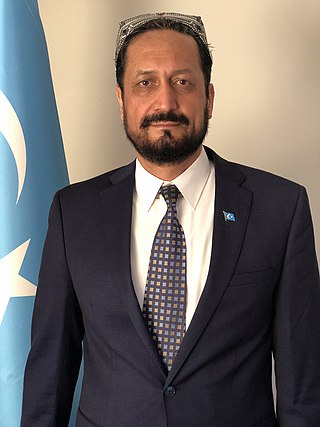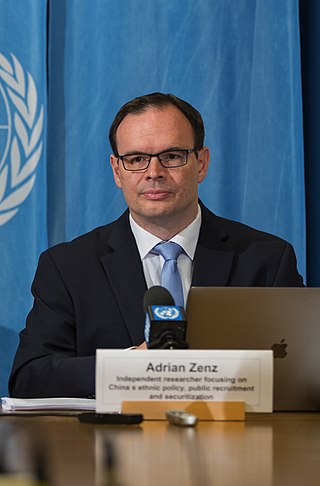Related Research Articles

The Uyghurs, alternatively spelled Uighurs, Uygurs or Uigurs, are a Turkic ethnic group originating from and culturally affiliated with the general region of Central and East Asia. The Uyghurs are recognized as native to the Xinjiang Uyghur Autonomous Region in Northwest China. They are one of China's 55 officially recognized ethnic minorities. The Uyghurs are recognized by the Chinese government as a regional minority and the titular people of Xinjiang.

East Turkestan is a loosely-defined geographical and historical region in the western provinces of the People's Republic of China, which varies in meaning by context and usage. The term was coined in the 19th century by Russian Turkologists, including Nikita Bichurin, who intended the name to replace the common Western term for the region, Chinese Turkestan, which referred to the Tarim Basin in the southwestern part of Xinjiang during the Qing dynasty. The medieval Persian toponym "Turkestan" and its derivatives were used by the local population as early as the 7th century. Historical manuscripts, dating back to the 7th and 9th century, found in the Turpan and Khotan regions, show that the name Turkestan was used to describe the region. The opening of the 11th century literary work Kutadgu Bilig by Kara-Khanid statesman Yusuf Khass Hajib also describes the region as Turkestan. Beginning in the 17th century, Altishahr, which means "Six Cities" in Uyghur, became the Uyghur name for the Tarim Basin. Uyghurs also called the Tarim Basin "Yettishar," which means "Seven Cities," and even "Sekkizshahr", which means "Eight Cities" in Uyghur. Chinese dynasties from the Han dynasty to the Tang dynasty had called an overlapping area the "Western Regions". The parts of this area conquered by the Manchu Qing Dynasty were termed "Xinjiang" from the 18th century on.

Ürümqi, formerly known as Dihua, is the capital of the Xinjiang Uyghur Autonomous Region in the far northwest of the People's Republic of China. Ürümqi developed its reputation as a leading cultural and commercial center during the Qing dynasty in the 19th century.

The Id Kah Mosque is a historic mosque and tourist site located in Kashgar, Xinjiang, China.
Uyghurlar is a book by historian Turghun Almas on the history of the "6,000 year history" of the Uyghur ethnic group of the Xinjiang region of China. It was published in the People's Republic of China in 1989, at a high point of liberalization of academic freedom and ethnic minority policy in China. It was one of the books of the period that presented an "alternative Uyghur history", based on Soviet historiography during the Sino-Soviet split, that advanced the thesis that the Uyghurs are the historical owner of Xinjiang and should have an independent state. It was also one of the first books to publicize the term East Turkestan, which suggests a kinship to a "West Turkestan" in the independent Central Asian states. In contrast to the official Chinese history of Xinjiang, which states that the region was an integral part of China since the Han dynasty, the book takes a nationalist view, saying that many "Uyghur" states throughout history were independent of or even dominant over, China.

The East Turkestan independence movement is a political movement that seeks the independence of East Turkestan, a large and sparsely-populated region in northwest China, as a nation state for the Uyghur people. The region is currently administered as a province-level subdivision of the People's Republic of China (PRC), under the official name Xinjiang Uygur Autonomous Region (XUAR). Within the movement, there is widespread support for the region to be renamed, since "Xinjiang" is seen by independence activists as a colonial name. "East Turkestan" is the best-known proposed name as it is the historical geographic name of the region and the name of the two independent states that briefly existed in the region in the first half of the 20th century.
Stephen Frederick Starr is an American expert on Russian and Eurasian affairs, a musician, and a former president of Oberlin College.
Terrorism in China refers to the use or threatened use of violence to effect political or ideological change in the People's Republic of China. The definition of terrorism differs among scholars, between international and national bodies and across time and there is no legally binding definition internationally. In the cultural setting of China, the term is relatively new and ambiguous.

The Uyghur Arabic alphabet is a version of the Arabic alphabet used for writing the Uyghur language, primarily by Uyghurs living in Xinjiang Uyghur Autonomous Region. It is one of several Uyghur alphabets and has been the official alphabet of the Uyghur language since 1982.

The Xinjiang clique was a military faction that ruled Xinjiang during China's warlord era. Unlike other cliques, its leaders were from outside the province.

Saifuddin Azizi, also known as Seypidin Azizi, Saif al-Dīn ʿAzīz, Saifuding Aizezi and Saifuding, was the first chairman of the Xinjiang Uyghur Autonomous Region of the People's Republic of China.
The incorporation of Xinjiang into the People's Republic of China in 1949, known in Chinese historiography as the Peaceful Liberation of Xinjiang, was the takeover of the Republic of China's Xinjiang Province by the Chinese Communist Party (CCP) and its People's Liberation Army, largely through political means, in the waning days of the Chinese Civil War.
A meshrep is a traditional male Uyghur gathering that typically includes "poetry, music, dance, and conversation within a structural context". Meshreps typically include music of the muqam variety and ad-hoc tribunals on moral questions.

Uyghurs in Pakistan are a small community of ethnic Uyghurs who live in Pakistan that originate from Xinjiang, China.
The Battle of Kashgar was a military confrontation that took place in 1934 during the Xinjiang Wars. Turkic Muslim Uyghur and Kirghiz fighters under Emir Abdullah Bughra and other Turkic separatists began four separate attacks over a six-day period on Hui and Han Chinese soldiers led by Gen. Ma Zhancang, trapping them inside Kashgar. Khoja Niyas Hajji joined the attack with his own Kumul Uyghur fighters after a 300-mile trek from Aksu - from which he was driven out by a force of Chinese Muslims — appearing at the walls of Kashgar on 13 January. The Chinese Muslim and Chinese forces repulsed the Turkic fighters, inflicting severe casualties upon them.

Anwar Yusuf Turani is a self proclaimed ethnic Uyghur nationalist and separatist leader. Born into a family branded counter-revolutionary by the Chinese government, Turani was raised in a labor camp where he faced economic hardship and political oppression. He attended Kashgar Teacher's College and graduated from the Department of Physics in July 1983. Turani came to the United States on August 12, 1988 and became the first Uyghur political asylee. In 1995, he established the East Turkistan National Freedom Center (ETNFC), a non-profit human rights organization based in Washington, D.C. He is the first person to start the East Turkistan independence movement in the United States. Having spearheaded the formation of the East Turkistan Government in Exile (ETGE) on September 14, 2004 in Washington, D.C., Turani went on to become the first Prime Minister of the entity.

Migration to Xinjiang is both an ongoing and historical movement of people, often sponsored by various states who controlled the region, including the Han dynasty, Qing dynasty, Republic of China and People's Republic of China.

Altishahr, also known as Kashgaria, is a historical name for the Tarim Basin region used in the 18th and 19th centuries. The term means 'Six Cities' in Turkic languages, referring to oasis towns along the rim of the Tarim, including Kashgar, in what is now southern Xinjiang Uyghur Autonomous Region of China.
The 6th Corps(Chinese: 第6军) was a military formation of the Chinese People's Liberation Army existed from 1949 to 1952.

Adrian Nikolaus Zenz is a German anthropologist known for his studies of the Xinjiang internment camps and Uyghur genocide. He is a director and senior fellow in China studies at the Victims of Communism Memorial Foundation, an anti-communist think tank established by the US government and based in Washington, DC.
References
- ↑ "Xinjiang: China's Muslim Borderland China's Muslim Borderland". Routledge. Retrieved January 2, 2016.
- ↑ Read, Benjamin L. (May 2006). "Reviewed Work: Xinjiang: China's Muslim Borderland by S. Frederick Starr". Journal of East Asian Studies. 6 (2): 315–317. doi:10.1017/S1598240800002381. JSTOR 23417910. S2CID 155525499.
- 1 2 3 de Vise, Daniel (August 20, 2011). "U.S. scholars say their book on China led to travel ban". The Washington Post. Retrieved January 2, 2016.